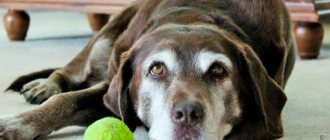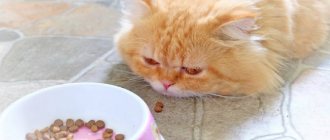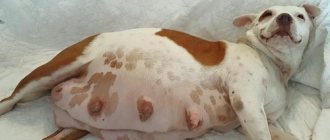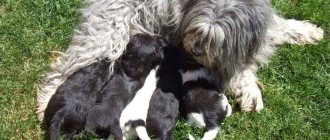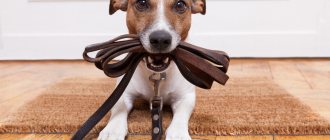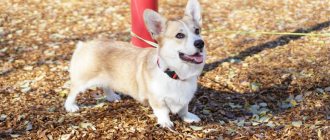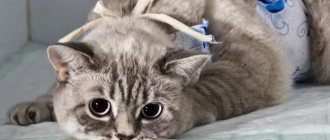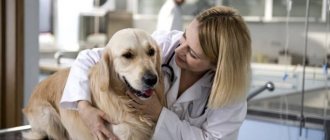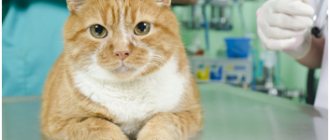After sterilization, dogs often gain excess weight. This is due to hormonal changes in the animal’s body. The pet, losing its sexual instinct, becomes more passive and begins to eat more than before castration. Therefore, after removal of the reproductive organs of the dog or bitch, they are put on a specialized diet. Veterinarians recommend feeding castrated animals commercial food for sterilized dogs. Natural nutrition is not prohibited, with some correction in the diet.
Changes in a dog's body after castration
It is better to castrate a dog at the age of 8–9 months so that it can recover faster after surgery and return to a normal lifestyle. Surgical intervention is necessary if you do not plan to reproduce your pet and want to correct its behavior.
The main change that occurs after sterilization is the stopping of the production of testosterone or estrogen in the dog's body. The animal becomes calmer, more sociable, begins to trust people and show friendliness towards them.
Another change is an increase in appetite, which causes many four-legged animals to gain weight. Dogs of both sexes reduce their physical activity and especially enjoy food and treats. Due to the rapid accumulation of calories and low energy expenditure, there is a risk of obesity, urolithiasis and other diseases. In this regard, after sterilization or castration, it is necessary to select a special diet in accordance with the individual needs of the dog.
When is it time to remove stitches and how does it happen?
The sutures are removed when the wound has healed completely. First, the animal is restrained, since the procedure, although not painful, is unpleasant. Then the doctor treats the skin in the suture area with an antiseptic, cuts the thread with scissors and removes it with tweezers. A cosmetic suture made from absorbable threads does not require removal.
As you can see, caring for your dog after surgery is necessary, but there is nothing terrible about it. A loving owner will need time, patience and strict adherence to the veterinarian’s instructions, then healing will be painless for everyone.
What other changes may occur after surgery?
- For some time after the operation, the pet will recover from anesthesia - within about a day. During the recovery period, it is better not to feed the animal at all. Over the next week, you need to give your pet soft food: canned food or dry food soaked in water.
- Low activity and weight gain come with other risks. Large breeds (Labradors, Huskies, etc.) are prone to diabetes, arthritis and hypertension. Medium and small dogs (dachshunds, Yorkshire terriers) may suffer from inflammation of the pancreas or suffer from joint dysplasia.
Why do dogs need to be given special food after sterilization?
The procedure of sterilization or castration changes the functioning mechanisms of the body. After surgery, the animal’s needs change, and accordingly, the diet needs to be adjusted to suit these needs.
Veterinarians are divided into two categories - some argue that castrated pets should be fed natural food, others - that special food with a balanced composition should be given. There are more second specialists. You need to choose a product carefully, in consultation with your doctor and focusing on the individual characteristics of the dog.
Industrial feed for animals in the postoperative period
Experienced breeders and veterinary specialists advise using the following types of commercial diets:
- Hill's SP Canine Perfect Weight Medium
- Farmina Vet Life Neutered
- Royal Canin Sterilized Series
- Pro Plan All Sizes Adult Light/Sterilised
- As well as analogues from Purina and Eukanuba.
Ideally, all these diets should be used from the moment the pet is sterilized throughout its subsequent life. This will prevent many problems, including obesity. But due to the rarity of such food, as well as the cost of the latter, many owners prefer to feed their pet natural food. It also cannot be called cheap (such a diet is often more expensive than an industrial diet), but you can buy everything listed below everywhere.
Which food to choose for spayed/neutered dogs?
Choosing the right food for an animal is quite difficult. You must strictly follow the veterinarian's recommendations so as not to harm the dog.
1. Select food according to product class
The lower the class of food, the more artificial ingredients, flavors, dyes and less vitamins, minerals, and other useful substances it contains. There are four categories of pet products:
- Economy These are the cheapest feeds with an unbalanced composition. You should not feed sterilized dogs with economy-class food, since after surgery the animal is weakened. Insufficiently mineralized food can cause vitamin deficiency, general malaise, weakened immunity, and exacerbation of chronic diseases.
- Premium These are foods in the middle price segment that contain high-quality natural ingredients and substances that are not suitable for all animals. Premium diets include special lines for dogs after sterilization, but there are very few of them; it is worth studying the composition in detail, especially the origin of animal proteins.
- Super premium. These are high-quality feeds with good sources of animal protein and various vitamins. They are balanced and do not contain artificial colors.
- Holistic. The diets consist only of natural ingredients, are made from the freshest raw materials, and have a rich composition of microelements. If you decide to castrate your pet, immediately look for food from the holistic class.
2. Choose food according to the dog’s breed
Mongrel dogs tolerate such operations better and recover faster after them. Such animals can be fed with premium products, for example, the manufacturer Brit has a line for sterilized pets, rich in L-carnitine, which helps reduce body fat.
Large breeds of dogs are more difficult to tolerate the castration procedure: their blood pressure and fat mass increase, and therefore the load on their joints. In this case, it is better to purchase dry and wet food of the super-premium and holistic classes.
Small breeds of dogs have small stomachs, expend a lot of energy and are able to eat small amounts of food at a time. Food for small animals should be very nutritious, filling, but low in calories. Holistic or super-premium products are perfect. The granules should be small so that the animal can easily chew them.
We recommend ordering food after consultation with a veterinarian or our manager.
3. We choose food according to the individual characteristics of the animal
- Elderly pets need a nutritious, low-calorie diet. The food should be enriched with vitamins, minerals and antioxidants. Diets for sterilized pets contain optimal levels of calcium, fatty acids and phosphorus.
- Animals prone to allergic reactions need grain-free food with hypoallergenic meat products. Choose pellets containing lamb, duck, turkey and northern fish. Avoid chicken and beef ingredients.
Owner reviews
Tatiana S.
My bull terrier is allergic. It took me a long time to find out what foods caused the rash on my stomach. The veterinarian advised me to switch to premium food. I bought different ones, he didn’t eat some foods, and his allergies intensified to others. I stopped holistically and have not had any skin problems for more than a year.
Vitaly. U
At the family council they decided to sterilize our Jessica. The operation was almost painless. She lay down for a day, and the next she ate and went for a walk. The dog is one year old and we fed her regular food from the table, but the doctor advised us to change her diet. We chose premium food and did not regret it, Jessica is healthy.
Basic requirements for composition
Dry food for sterilized animals should be low in calories to avoid obesity. Pets' appetite increases by 50%, and metabolism decreases by 10%. We have many formulations specifically designed for neutered dogs. In special lines, the volume of fat is reduced by 12–13%, and the proportion of protein, on the contrary, increases so that pets do not feel hungry. Additionally, the feed is enriched with antioxidants and vitamins. Let's take a closer look at the requirements for the composition of products.
1. Proteins
Neutered animals should be fed food containing easily digestible proteins. Manufacturers of super-premium and holistic products add ocean fish, natural lamb and turkey as protein components.
Additionally, L-carnitine is added for fat burning.
2. Fats
In food for sterilized animals, the amount of lipids is reduced, as they are a cause of weight gain and a source of calories. Neutered dogs should be fed foods with healthy Omega-3 and Omega-6 fats. Sources of lipids are usually flaxseeds, vegetable oils and natural fish.
3. Carbohydrates
The diet of neutered dogs should be high in fiber and low in starch. Fiber improves the animal’s digestion and provides long-lasting satiety. Good feeds will use brown rice, oats and barley as grain crops. Wheat and corn are too heavy ingredients for pets who have undergone surgery.
4. Additives
Neutered pets need to be provided with vitamins and minerals to maintain health and quickly recover. Good food already contains the necessary additives; they do not need to be purchased separately.
Dogs over 5 years old should be given calcium to strengthen bones, B vitamins, phosphorus, glucosamine, biotin and other components.
Briefly about the main thing
- Sterilization and castration of a dog should be carried out by veterinarians in a clinic where emergency assistance can be provided in case of complications.
- If your veterinarian advises you to change food to something more expensive and of higher quality, you should listen. It will be cheaper than treating your pet for concomitant diseases.
- Buy food from trusted stores; there are a lot of fakes on the market, in the premium and holistic segments.
- When choosing what to feed your dog, study information about the full composition on the Internet, read reviews on food forums. You can identify shortcomings from different manufacturers that will not be written about on official websites.
- Before purchasing a large volume, take a sample and give it to your pet to try. If you like it, you can safely go to the store or order food delivered to your home.
The article is based on the expert opinion of the author; consult a specialist before use.
Prohibited Products
If you decide to castrate your dog, you need to make sure that the animal’s diet does not contain the following products:
- fat meat;
- potato;
- sweet products;
- pastries and bread;
- legumes;
- smoked products;
- fried foods;
- canned food intended for people.
Natural nutrition
A sterilized animal can be fed natural foods, but you should consult your veterinarian before choosing this type of food. A specialist may prescribe vitamins or other supplements that are not found in natural foods.
In the first two weeks after sterilization, it is recommended to divide the daily intake into 4 meals, gradually returning to normal feeding. The diet should consist predominantly of protein, with a reduced amount of carbohydrates and fats.
You can use lean meat (beef, turkey) as the main product; you can add heart or kidneys. Once every 3-4 days it is allowed to feed the animal low-fat sea fish. Once every 7 days - boiled or raw egg.
Fermented milk products must be present in the diet: kefir, cottage cheese, etc. Milk should not be given to animals over one and a half years old.
Be sure to feed your dog raw vegetables and fruits, in small quantities. This is necessary to improve digestion.
Rating of the best food for spayed/neutered dogs
What to feed a neutered dog? Let's consider the rating of popular brands that produce lines for sterilized animals.
1. Brit
The Brit brand belongs to the premium class and produces a special line for neutered pets. The basis of the diet is protein - 25% rabbit meat and 15% salmon. The lipid component is chicken and fish oil from salmon, and flaxseed. Buckwheat is used as a carbohydrate. Brit food is supplied with all the necessary vitamins and minerals for the health of furbabies after major surgery.
2. Ambrosia
The manufacturer produces holistic products and offers a wide range of food for older animals, sterilized dogs prone to rapid weight gain. It contains only natural ingredients: fresh turkey (30%), dehydrated chicken (17%), flaxseed and chicken fat, salmon meal and other components.
Ambrosia food is supplied with various vitamins and healthy nutritional supplements. Such a nutritious diet is what is needed to restore the health of the animal.
3.Prolife
A complete holistic product contains components for the prevention of excess weight gain and urolithiasis. The special vitamin complex in Prolife food helps maintain the health of the dog’s skin, coat, bones and joints, ensures the normal functioning of the immune system and strengthens the protective functions of the intestines.
The food for sterilized pets contains 50% pork, chicken fat, white and brown rice and other raw materials of the same quality as for use in human food.
4. Farmina
Farmina produces super-premium products for sterilized pets. The line contains a large number of ingredients of animal origin, reduces the risk of allergic reactions and ensures your pet a long, happy life.
The feed contains 20% duck, 20; dehydrated protein, chicken fat, sweet potato and other ingredients. The products are supplied with vitamins and minerals for the pet’s rapid recovery after surgery.
Features of anesthesia and its consequences
The duration of the surgical intervention is less than an hour, but the owner is always given a margin of waiting time. This is necessary to recover from anesthesia. The speed of awakening depends on the type of anesthesia chosen:
- analgesics and muscle relaxants – 5-24 hours;
- epidural anesthesia and muscle relaxants – 8 hours;
- gas anesthesia - immediately after the anesthesia is turned off.
The first option is most often used, so full recovery occurs at home. At the veterinary clinic, they wait only for the moment when the four-legged animal opens its eyes and begins to respond to external stimuli.
In addition to the long awakening time, general anesthesia has other disadvantages:
- reduces blood pressure and temperature;
- reduces heart rate and breathing.
If you are intolerant to the administered drug, an allergy is also possible. More severe complications include pulmonary edema and stroke, but they usually only occur in older dogs and pets with chronic pathologies. Thanks to a thorough preoperative examination and individual selection of the dose of anesthetic, the likelihood of unpleasant consequences is minimal.
How to properly feed your dog after spaying or neutering
At first, your dog may experience constipation, so you need to give liquid or semi-liquid food. If the animal does not want to eat, there is no need to force food. If your pet does not eat for more than 3 days, this is a reason to contact a veterinarian.
Remember that food for a castrated or sterilized animal must be selected carefully, because the health of the pet depends on its quality. Also, to avoid negative consequences, it is necessary to undergo a preventive examination at a veterinary clinic every year. Surround your furry with love, care, and don’t skimp on food. Remember that it depends on the owners how comfortable the dog will feel and how quickly it will recover.
